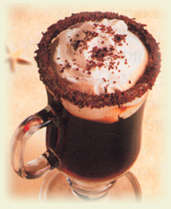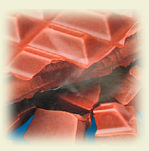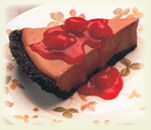The cocoa tree grows in tropical rainforests, particularly in the Ivory Coast of Africa, Brazil, Venezuela, and Ghana. The cocoa fruits (or pods) are found on the trunk and older branches, and each pod contains 20 to 50 seeds or beans. When the fruits are harvested, the beans are scooped out and fermented in wood crates for 3 to 9 days. The beans are then dried, roasted and ground to release the fat and aromatic substances, and the cocoa is refined. About 400 cocoa beans are needed to produce one pound of chocolate.
Milk chocolate is a mixture of cocoa paste, cocoa butter, sugar, and substantial quantities of powdered milk.
For more information about the origin and processing of chocolate, try these sites: www.pastrywiz.com/letseat Benefits of Eating Chocolate Chocolate has exceptional nutritional qualities, being a high energy food in a small volume. It not only contains carbohydrates, fats, and vegetable proteins, but also has large quantities of potassium and magnesium, some calcium and sodium, and vitamins A1, B1, B2, D, and E. Chocolate contains a number of other substances in small, but effective, quantities: Theobromine, which stimulates the central nervous system, facilitates muscular exertion, acts as a diuretic and appetite stimulant. Caffeine, which increases resistance to fatigue, intellectual activity, and watchfulness. An average size chocolate bar contains approximately 6 mg of caffeine, compared to 100-150 mg in a cup of coffee.
Tryptophan, an essential amino acid that increases the production of serotonin, an anti-depressant and natural stress-reducer. In fact, a decrease in serotonin levels in the brain may trigger cravings for starches, sweet foods and chocolate. Endorphins, natural opiates that are released by the brain in increased amounts when eating chocolate, thereby elevating one's mood and reducing pain. Phenols,which are also found in red wine, tea, fruits and vegetables, and may help reduce the risk of coronary heart disease. Catechins, which are antioxidants that may help protect the body against cardiovascular disease and possibly cancer, are found in substantially higher quantities in chocolate than in black tea. Anandamide, which mimics the effects of marijuana by acting on the same brain receptors, resulting in a very mild "high". Plus, chocolate has two ingredients that inhibit the natural breakdown of anandamide and hence may prolong the feeling of well-being. Do these facts tempt you to learn more about chocolate? Then check out these websites: www.chocolate.org And other irresistible sites for the true chocoholic include: www.virtualchocolate.com - An excellent site, with a newsletter, chocoholics club, and lots of recipes. The Chocolate Scoop - The Ultimate Chocolate Newsletter. The M&M's Factory - How many red ones are in a pack, really? Edelweiss Chocolates of Beverly Hills
|


 The
history of chocolate traces its
roots back to the Aztecs. During Emperor Montezuma’s reign, cocoa
beans were so valuable that they were used as currency. Cocoa, prepared
as a chocolate drink, was believed to impart wisdom, provide great
energy and have aphrodisiacal powers. Montezuma greeted explorer Hernando
Cortez with gold, silver and cocoa, and Cortez brought Montezuma’s
special drink recipe back to Spain. The Spaniards added hot water,
sugar, vanilla and cinnamon, and the drink became all the rage among
European nobles. It then became so popular in France that chocolate
houses, much like today’s coffee houses, appeared. Later, the
Swiss made the most refinements to cocoa, creating the processing
system still used today. The Swedish naturalist, Linnaeus, christened
the chocolate plant Theobroma cacao, Latin for "food
of the gods".
The
history of chocolate traces its
roots back to the Aztecs. During Emperor Montezuma’s reign, cocoa
beans were so valuable that they were used as currency. Cocoa, prepared
as a chocolate drink, was believed to impart wisdom, provide great
energy and have aphrodisiacal powers. Montezuma greeted explorer Hernando
Cortez with gold, silver and cocoa, and Cortez brought Montezuma’s
special drink recipe back to Spain. The Spaniards added hot water,
sugar, vanilla and cinnamon, and the drink became all the rage among
European nobles. It then became so popular in France that chocolate
houses, much like today’s coffee houses, appeared. Later, the
Swiss made the most refinements to cocoa, creating the processing
system still used today. The Swedish naturalist, Linnaeus, christened
the chocolate plant Theobroma cacao, Latin for "food
of the gods".  Bitter
chocolate is made by mixing cocoa paste with small amounts of
sugar.
Bitter
chocolate is made by mixing cocoa paste with small amounts of
sugar. Phenylethylamine,
which is the chemical released in our bodies when we fall in love
and is chemically similar to amphetamines, therefore acting as a psycho-stimulant.
Phenylethylamine,
which is the chemical released in our bodies when we fall in love
and is chemically similar to amphetamines, therefore acting as a psycho-stimulant.